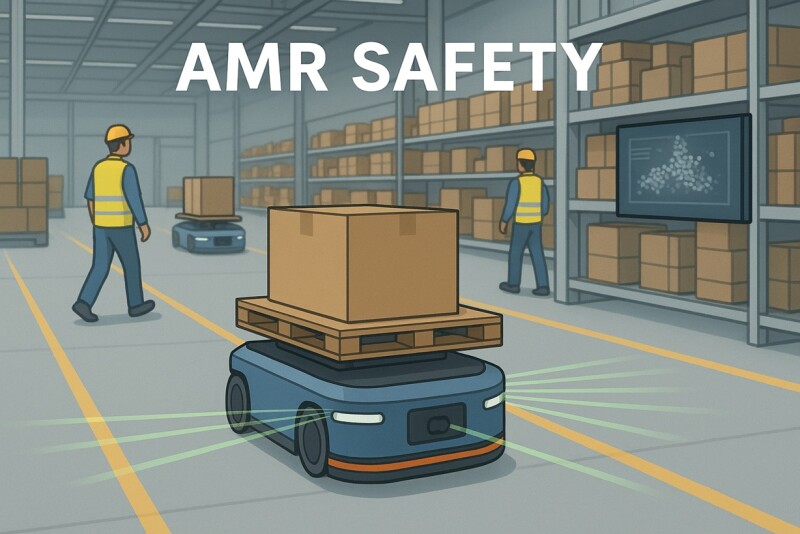Warehouse Safety for AMRs: Sensors, Vision, and AI
Autonomous Mobile Robots (AMRs) are revolutionizing warehouse logistics — but with this autonomy comes a new challenge: ensuring safety in dynamic, human-rich environments. From real-time obstacle detection to predictive collision avoidance, modern AMR safety depends on the fusion of sensors, vision systems, and artificial intelligence.
Safety Standards for Autonomous Vehicles
The key safety reference for AMRs is ISO 3691-4, which defines the requirements for driverless industrial trucks and systems. It covers braking distances, emergency stops, and functional safety architecture — aligning with Functional Safety (PL/SIL) principles from traditional automation.
In practice, compliance means ensuring that even under software failure, the robot stops safely and maintains controlled motion. AI assists by monitoring sensor data continuously to detect anomalies and trigger safe reactions automatically.
Core Sensor Technologies in AMR Safety
Modern AMRs use a blend of perception systems to detect obstacles, humans, and environmental features:
- LIDAR scanners — provide 360° distance measurement and area protection.
- Stereo and 3D cameras — enable object recognition and human detection.
- Ultrasonic sensors — detect low-level obstacles or reflective surfaces.
- IMUs and wheel encoders — ensure precise motion feedback and stability.
This sensor redundancy mimics the layered approach used in cobot safety systems, where both physical and intelligent safeguards work together to prevent incidents.
AI and Computer Vision for Safer Navigation
AI-driven vision models classify obstacles and predict human movement patterns. For example, convolutional neural networks (CNNs) identify forklifts, pallets, and workers in real time, allowing AMRs to adjust paths dynamically. This continuous perception loop enables smoother operation and higher throughput compared to simple obstacle-stop logic.
Some systems even integrate Edge AI modules directly onboard each AMR, reducing latency and keeping safety decisions local — even without cloud connectivity.
Cybersecurity and Safety Overlap
As AMRs become connected to cloud and warehouse management systems, cybersecurity directly impacts safety. A compromised communication link could lead to erratic behavior or stopped operations. That’s why NIS2 for Manufacturers mandates secure communication and authentication in operational technology networks.
In 2025, safety and security are inseparable. Firewalls, network segmentation, and encrypted channels protect both data and people on the warehouse floor.
Human Awareness and Collaboration
Advanced AMRs don’t just avoid humans — they understand them. Using 3D vision and behavior prediction, robots can identify when an operator intends to cross their path or stop suddenly. Some systems project visual cues, like light paths or direction arrows, to make their movement predictable to human coworkers.
This approach echoes collaborative design from cobot safety standards, applied now to mobile robots in logistics.
Testing and Validation
Before deployment, safety systems are validated through simulation and route testing. Digital twins replicate warehouse layouts, traffic density, and human behavior to ensure every sensor and safety function performs as expected.
Related Articles
- AMR vs AGV in 2025: What’s the Real Difference for Smart Intralogistics?
- How AI Optimizes AMR Fleet Management
- Intralogistics Automation ROI: Calculating the Payback of AMRs
- From Simulation to Deployment: How to Test AMR Routes
- Functional Safety (PL/SIL) in Industrial Automation
- NIS2 for Manufacturers: What It Means for Operational Technology
- Edge AI in the Factory: How Smart Devices Bring AI Closer to Production
Quick Q&A
Q: What’s the most important sensor for AMR safety?
A: LIDAR — it provides reliable 360° coverage and is the foundation for all obstacle avoidance.
Q: Can AI fully replace physical safety devices?
A: Not yet. AI complements but doesn’t replace mandatory safety-rated hardware defined by ISO 3691-4.
Q: How do I validate AMR safety performance?
A: Combine simulation, field testing, and documented compliance reports from certified integrators.
Conclusion
Warehouse safety for AMRs is a fusion of technology and discipline. By combining redundant sensors, AI-driven vision, and secure connectivity, facilities can achieve both safety and productivity. The result: smarter, safer, and more collaborative logistics — where humans and robots share the same floor with confidence.









































Interested? Submit your enquiry using the form below:
Only available for registered users. Sign In to your account or register here.